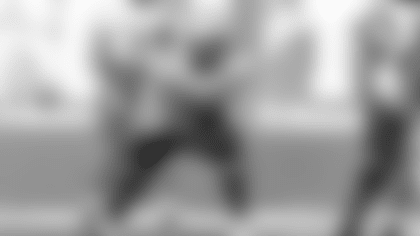
Some people collect coins. Some collect stamps. During the 1990 NFL Draft, the Jets collected wide receivers.
They chose West Virginia's Reggie Rembert in the second round, Terance Mathis from New Mexico in the sixth round, and the University of Miami's Dale Dawkins in the ninth round. And then for good measure, Syracuse's Rob Moore was picked in the first round of the supplemental draft 11 weeks later.
Dawkins, who helped the Hurricanes win two National Championships and led them with 54 receptions for 833 yards and seven touchdowns as a senior, heard his name called later during the draft than he expected, but was grateful that it was even called at all.
"There were rumors that I was supposed to go a little bit higher, but the Jets, when they called me, it was. 'Hey, I know you may be a little bit disappointed where you got drafted at, but we're very excited to have you on the football team,'" Dawkins said. "I was just happy to get that phone call, to be honest with you. It was a really good experience."
With so many rookies in the wide receivers room, Dawkins wasn't surprised that some of the veterans were initially a little standoffish. After all, only so many could make the team. But…
"The good thing for us was that Bruce Coslet was coming in (as the head coach), and we were part of his draft class," Dawkins said. "So I knew, according to what my agent was telling me, 'Hey, you've got a pretty good chance if you just go in and take care of business.' Once you got in and got your feet wet, and guys kind of sized you up, Al Toon, JoJo Townsell and Chris Burkett, they were a huge help to us.
"(And receivers coach) Chip Myers was always up front, 'Hey, you need to do whatever you need to do to get on this team.' I knew I was going to have to show up on special teams. And at the same time, I knew that if I got an opportunity at wide receiver, I was going to be coming in on third down at that particular time."
After injuring his knee during the preseason, Dawkins began his rookie year on injured reserve. Activated to the roster on October 13, he played the final 11 games primarily on special teams and notched seven tackles.
"It was an opportunity to not take the lick, but to give one," Dawkins laughed. "You did whatever you could to get on the field, to help the team and give yourself an opportunity to be seen. Because when we first came in, they told you right away, 'The NFL stands for not for long.' And so you did whatever you had to do to make sure that you were a part of that 53-man roster."
Contributing 10 special teams tackles and three receptions for 38 yards through 15 games the following year, on December 17, five days before the regular-season finale in Miami, Dawkins was involved in a late-night car accident on Long Island's Northern State Parkway when he hit a tree.
Suffering a severely broken right leg, Dawkins was initially treated at Winthrop Hospital in Mineola, and then transferred to Lenox Hill Hospital in Manhattan, where he underwent surgery and had a metal rod inserted in his thighbone.
Realizing that he faced a challenging rehabilitation, Dawkins wasn't thrilled to hear that there were doubters and even less so about how he heard it.
"When I was watching the game, the commentators were talking about, 'Yeah, Dale Dawkins sustained a career-ending injury.' And that was the first time I had heard that. Of course, that was pretty devastating to actually hear someone say that because they had to get that information from somewhere," Dawkins said.
It would have been fair to deduce that he didn't feel that it came from any of the team's trainers or doctors.
"They never made me feel like I was not going to be a part of the team," Dawkins said. "The next day after the surgery, they had me right up out of bed, walking. Within a week, they had me walking on my own. And then a month or two after that, lifting weights and riding a bike. They had me doing just unbelievable workouts to build muscle to bring strength back to that leg.
"I was very thankful that the doctors would spend that much time. They'd fly me up (from my offseason home in Florida) just to make sure there was no infection developing in my leg because of all the rigorous workouts that they had me doing to strengthen my entire body. Then over the summer, they gave me all these different workouts to build speed.
"So it was really up to me. They put everything in front of me. I mean, they couldn't do the work for me. I had to bust my behind, and I was just thankful that they were willing to put the time in and to make sure I was on the right track that would give me a good shot to make that team again."
Which he did. First placed on the non-football injury list, Dawkins worked his way onto the Jets' 1992 practice squad. And then prior to New York's Week 12 game at New England, he heard eight words that he wasn't sure he'd ever hear.
"They came and said, 'You're going to be activated for this game.' And that's when everything just kind of hits you. All the hard work. All the long nights. Everything that you go through to just try to get your body in a position to perform at that level. I mean, you have to feel really good about all the work you put in," said Dawkins, who was voted by his teammates to receive the Ed Block Courage Award, which recognizes a player as a role model for inspiration, sportsmanship and courage.
"And for the organization to say, 'We trust you, and we want you to be a part of what we're doing.' Because they could have just said, 'Hey, just get him into camp and then we can be done with this.' But the Jets stood by me the entire way. So, yeah, the emotions really hit me. I couldn't be more thankful to be a part of an organization that was willing to stand by their commitment to their players. They showed that with me."
Finishing his playing career in 1994, for the past six years, Dawkins has worked at St. Peter's Preparatory Academy School in Vero Beach, FL, with children at risk.
"It's a huge, fulfilling role that I play," Dawkins said. "I get a chance to talk to kids who walk the same path that I walked. And get a chance to share, 'Hey, I wasn't the brightest kid in the world either at the time. But it's all on what you put into it. I lived in the same community. If I did it, you can do it.'
"I love sharing those moments that whatever you set your heart and mind to, it's available if you're willing to put in the work for it. I really enjoy challenging these kids. That you've got a lot of life ahead of you, and there's a lot of good things that can happen. It's a small school and I love it because you get significant time with the kids to really mentor and kind of help them see a bigger vision."
And when Dawkins sees that he's making a big difference in a child's life…
"This may be something that happens to all of us when we reach a certain age in life, you get more emotional," he said. "Just the emotion of seeing the smile on the kid that was hesitant to step out because of the fear of failure. Just the way that they light up, it really, really means a lot to be able to see those kids be willing to be vulnerable and take those steps."
Dawkins and his ex-wife, Lori, have five children: Alexa, Kassady, Blake, Jadyn, and Giana; and three grandsons. And what's the best thing about being him today?
"Oh, man, this may not sound right, but I love my life," Dawkins said. "I love the things that I was able to accomplish. I like the fact that I get to be here helping give back to a community that gave so much to me. There's nothing greater than that for me. That I can give back in the manner in which I give back. To thank those that took the time out to help me realize my potential."














